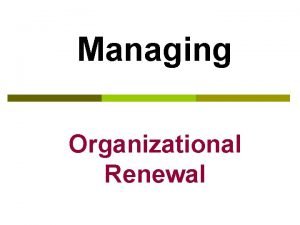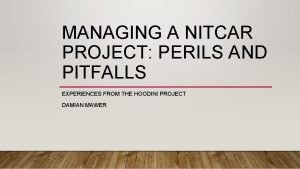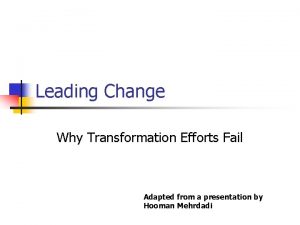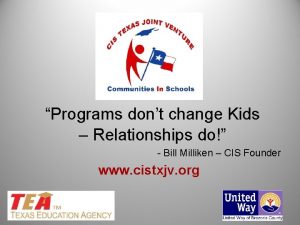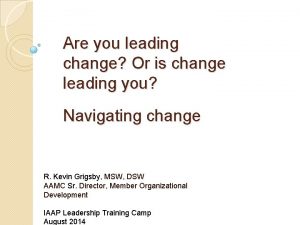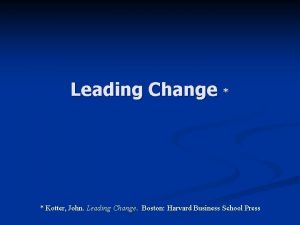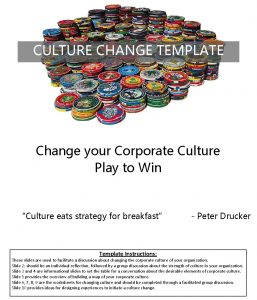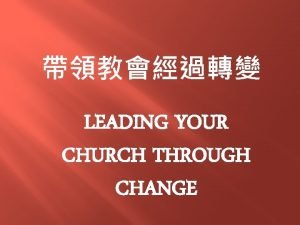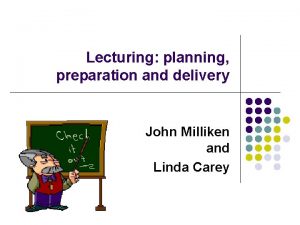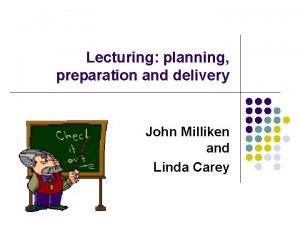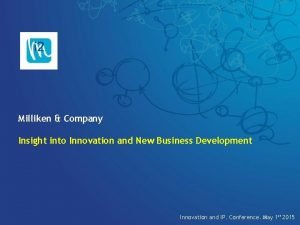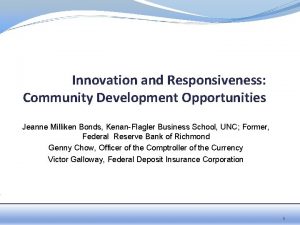Leading and Supporting Your Culture Change 2011 Milliken


















- Slides: 18

Leading and Supporting Your Culture Change © 2011 Milliken Design, Inc.

What is Associate Engagement? What is Empowerment? How does Engagement Occur? © 2011 Milliken Design, Inc.

How Engagement Occurs Hierarchy of Human Needs Self Actualization Problem Solving e. Steem Respect of self/others Social Part of something Security Survival © 2011 Milliken Design, Inc. Clothing/Shelter Air/Water/Food

The “Engagement” Curve 1. Lead user – first to engage 2. Early adopters – engage with minimal encouragement 3. Routine users – engage with encouragement 4. Laggards – engagement with pressure 5. Others – never engage, opt out 1 2 3 © 2011 Milliken Design, Inc. 4 5

Creating “Engagement” • • Associates • Pillars Pillar teams Project /deployment teams Work teams • • • Education Job specific Standard work Problem solving Pillar steps Pillar methods • • Measurement Performance Feedback boards Review & response Individual accountability • • • Recognition Individual Team Target based Sharing case studies Formal Engagement Provide the Prepare people Measure, track & opportunity to be successful provide feedback Reinforce the behavior …through performance system implementation © 2011 Milliken Design, Inc.

Resistance to change is normal and should be expected. Why do people resist change? © 2011 Milliken Design, Inc.

Primary reasons front line employees resist change 1. 2. 3. Employees were not aware of the business need for change. Employees did not understand why a change was being made nor did they understand how the change would impact them (WIIFM - what's in it for me). Without this awareness employees could not evaluate and align their loyalties and dedication to the change. Lay-offs were announced or feared as part of the change. Employees were concerned at the prospect of being unemployed and the direct financial implications involved. Occasionally, changes are viewed as nothing more than staff reduction exercises. Employees were unsure if they had the skills needed for success in the future state. Employees were concerned about new responsibilities, changing technologies and whether they would be able perform well under a new performance measurement system. © 2011 Milliken Design, Inc. Source: Prosci

Primary reasons front line employees resist change 4. 5. 6. Individuals were comfortable with the current state. Employees wanted to maintain the personal rewards and sense of accomplishment and fulfillment provided by the status quo. They felt threatened by the perceived personal loss of identity or expertise; loss of autonomy and in some cases a loss of admiration or respect within the organization. Employees believed they were being asked to do more with less, or do more for the same pay. Other reasons front-line employees resisted change were: – – – a history of failed change in the organization too much change was already going on an entitlement culture a lack of specific and timely details surrounding the change lack of involvement in the change © 2011 Milliken Design, Inc. Source: Prosci

Role of Change Management Leadership Change Management Approach Awareness Desire Management Knowledge Ability Accepting A New Way Of Working Reinforcement Employees © 2011 Milliken Design, Inc. Source: Prosci

Critical successfactors for change Awareness + Desire + Knowledge + Ability + Reinforcement CHANGE Awareness + Desire + Knowledge + Ability + Reinforcement Lack of purpose Awareness + Desire + Knowledge + Ability + Reinforcement Lack of motivation Awareness + Desire + Knowledge + Ability + Reinforcement Lack of interest Awareness + Desire + Knowledge + Ability + Reinforcement © 2011 Milliken Design, Inc. Frustration Non sustaining

Communication Plan Who Receiver Sender What Message © 2011 Milliken Design, Inc. When Timing How Medium

The Vision • What is the company’s aspirational vision? © 2011 Milliken Design, Inc.

Business Case for Change (BCFC) Simply put, the business case for change defines and documents what got us here today, will not get us where we want to go tomorrow. + © 2011 Milliken Design, Inc.

What’s In It For Me? • What’s In It For Me (WIIFM)? – This will be a fundamental question that the communication strategy must address time and time again – WIIFM clearly defines why an associate should care about the changes that are about to come their way • What and how will these changes affect me? © 2011 Milliken Design, Inc.

Rewards and Recognition Informal Rewards Recognition © 2011 Milliken Design, Inc. Formal

Describe the leadership characteristics Driving Engagement Through the Implementation in “Traditional Management” Traditional Management 40% 60% Daily Operations Firefighting Describe the leadership in “Operational Excellence Organizations” The Best in the World 20% Daily Operations 20% Firefighting Routine 60% Continuous Improvement/ Innovation Working Through Cross-Functional Teams © 2011 Milliken Design, Inc.

Leadership Styles • • • Traditional top-down directive delegating low support dictating • • • Empowering bottom-up coaching encouraging supporting enabling collaborative © 2011 Milliken Design, Inc.

Role of Leadership • • • Provide the opportunity Encourage – change management leader Establish the expectation Provide the education and training Measure and track Hold people accountable, responsible Recognize the right behavior Recognize performance Empower the people / teams Establish the environment © 2011 Milliken Design, Inc.
 Milliken vs bradley
Milliken vs bradley Bobbin leading and flyer leading
Bobbin leading and flyer leading Enagic compensation plan
Enagic compensation plan Leading change and organizational renewal
Leading change and organizational renewal Leading change and organizational renewal
Leading change and organizational renewal The perils and pitfalls of leading change case solution
The perils and pitfalls of leading change case solution John kotter leading change why transformation efforts fail
John kotter leading change why transformation efforts fail Leading through change presentation
Leading through change presentation Examples of popular culture
Examples of popular culture Batch culture vs continuous culture
Batch culture vs continuous culture Difference between american and indian culture
Difference between american and indian culture Uses of selenite f broth
Uses of selenite f broth Folk culture and popular culture venn diagram
Folk culture and popular culture venn diagram Chapter 4 folk and popular culture
Chapter 4 folk and popular culture Anerobic media
Anerobic media Folk culture and popular culture venn diagram
Folk culture and popular culture venn diagram Anaerobic gaspak
Anaerobic gaspak Lawn or carpet culture
Lawn or carpet culture Surface culture deep culture and esol
Surface culture deep culture and esol



